Effects of Land Use and Land Cover Change on Temperature in Summer over the Yellow River Basin, China
Abstract
:1. Introduction
2. Materials and Methods
2.1. Study Area
2.2. Model Description and Configuration
2.3. Experimental Design
2.4. Model Evaluation
3. Results
3.1. WRF Model Evaluation
3.2. Land Use and Land Cover Change
3.3. Impact of LUCC on T2 m
4. Discussion
5. Conclusions
Author Contributions
Funding
Data Availability Statement
Acknowledgments
Conflicts of Interest
References
- Cao, Q.; Yu, D.Y.; Georgescu, M.; Han, Z.; Wu, J.G. Impacts of land use and land cover change on regional climate: A case study in the agro-pastoral transitional zone of China. Environ. Res. Lett. 2015, 10, 124025. [Google Scholar] [CrossRef]
- Feddema, J.J.; Oleson, K.W.; Bonan, G.B.; Mearns, L.O.; Buja, L.E.; Meehl, G.A.; Washington, W.M. The importance of land-cover change in simulating future climates. Science 2005, 310, 1674–1678. [Google Scholar] [CrossRef] [PubMed]
- Foley, J.A.; DeFries, R.; Asner, G.P.; Barford, C.; Bonan, G.; Carpenter, S.R.; Chapin, F.S.; Coe, M.T.; Daily, G.C.; Gibbs, H.K.; et al. Global Consequences of Land Use. Science 2005, 309, 570–574. [Google Scholar] [CrossRef]
- Turner, B.L.; Lambin, E.F.; Reenberg, A. The emergence of land change science for global environmental change and sustainability. Proc. Natl. Acad. Sci. USA 2007, 104, 20666–20671. [Google Scholar] [CrossRef] [PubMed]
- Deng, X.Z.; Zhao, C.H.; Yan, H.M. Systematic Modeling of Impacts of Land Use and Land Cover Changes on Regional Climate: A Review. Adv. Meteorol. 2013, 2013, 317678. [Google Scholar] [CrossRef]
- Li, D.; Tian, P.P.; Luo, H.Y.; Hu, T.S.; Dong, B.; Cui, Y.L.; Khan, S.; Luo, Y.F. Impacts of land use and land cover changes on regional climate in the Lhasa River basin, Tibetan Plateau. Sci. Total Environ. 2020, 742, 140570. [Google Scholar] [CrossRef]
- Chen, L.; Ma, Z.G.; Zhao, T.B. Modeling and analysis of the potential impacts on regional climate due to vegetation degradation over arid and semi-arid regions of China. Clim. Chang. 2017, 144, 461–473. [Google Scholar] [CrossRef]
- Hua, W.J.; Chen, H.S.; Sun, S.L.; Zhou, L.M. Assessing climatic impacts of future land use and land cover change projected with the CanESM2 model. Int. J. Climatol. 2015, 35, 3661–3675. [Google Scholar] [CrossRef]
- Chi, Q.; Zhou, S.H.; Wang, L.J.; Zhu, M.Y.; Liu, D.D.; Tang, W.C.; Cui, Y.P.; Lee, J. Exploring on the Eco-Climatic Effects of Land Use Changes in the Influence Area of the Yellow River Basin from 2000 to 2015. Land 2021, 10, 601. [Google Scholar] [CrossRef]
- Lama, G.F.C.; Crimaldi, M. Remote Sensing of Ecohydrological, Ecohydraulic, and Ecohydrodynamic Phenomena in Vegetated Waterways: The Role of Leaf Area Index (LAI). Biol. Life Sci. Forum 2021, 3, 54. [Google Scholar]
- Hua, W.J.; Chen, H.S.; Li, X. Effects of future land use change on the regional climate in China. Sci. China Earth Sci. 2015, 58, 1840–1848. [Google Scholar] [CrossRef]
- Li, X.; Chen, H.S.; Liao, H.; Hua, W.J.; Sun, S.L.; Ma, H.D.; Li, X.; Gao, C.J.; Zhu, S.G. Potential effects of land cover change on temperature extremes over Eurasia: Current versus historical experiments. Int. J. Climatol. 2017, 37, 59–74. [Google Scholar] [CrossRef]
- Bonan, G.B. Observational evidence for reduction of daily maximum temperature by croplands in the Midwest United States. J. Clim. 2001, 14, 2430–2442. [Google Scholar] [CrossRef]
- Du, H.B.; He, H.S.; Wu, Z.F.; Wang, L.; Zong, S.W.; Liu, J. Human influences on regional temperature change-comparing adjacent plains of China and Russia. Int. J. Climatol. 2017, 37, 2913–2922. [Google Scholar] [CrossRef]
- Shi, H.Y.; Chen, J. Characteristics of climate change and its relationship with land use/cover change in Yunnan Province, China. Int. J. Climatol. 2018, 38, 2520–2537. [Google Scholar] [CrossRef]
- Mortoja, M.G.; Yigitcanlar, T. Local Drivers of Anthropogenic Climate Change: Quantifying the Impact through a Remote Sensing Approach in Brisbane. Remote Sens. 2020, 12, 3938. [Google Scholar] [CrossRef]
- Zhao, W.; Xiong, D.H.; Wen, F.P.; Wang, X.D. Lake area monitoring based on land surface temperature in the Tibetan Plateau from 2000 to 2018. Environ. Res. Lett. 2020, 15, 084033. [Google Scholar] [CrossRef]
- Zhou, D.C.; Xiao, J.F.; Frolking, S.; Liu, S.G.; Zhang, L.X.; Cui, Y.P.; Zhou, G.Y. Croplands intensify regional and global warming according to satellite observations. Remote Sens. Environ. 2021, 264, 112585. [Google Scholar] [CrossRef]
- Yu, L.X.; Liu, T.X. The Impact of Artificial Wetland Expansion on Local Temperature in the Growing Season-the Case Study of the Sanjiang Plain, China. Remote Sens. 2019, 11, 2915. [Google Scholar] [CrossRef]
- Du, J.Y.; Watts, J.D.; Jiang, L.M.; Lu, H.; Cheng, X.; Duguay, C.; Farina, M.; Qiu, Y.B.; Kim, Y.; Kimball, J.S.; et al. Remote Sensing of Environmental Changes in Cold Regions: Methods, Achievements and Challenges. Remote Sens. 2019, 11, 1952. [Google Scholar] [CrossRef]
- Yang, J.; Gong, P.; Fu, R.; Zhang, M.H.; Chen, J.M.; Liang, S.L.; Xu, B.; Shi, J.C.; Dickinson, R. The role of satellite remote sensing in climate change studies. Nat. Clim. Chang. 2013, 3, 875–883. [Google Scholar] [CrossRef]
- Kong, X.H.; Wang, A.H.; Bi, X.Q.; Wang, D. Assessment of Temperature Extremes in China Using RegCM4 and WRF. Adv. Atmos. Sci. 2019, 36, 363–377. [Google Scholar] [CrossRef]
- Fita, L.; Evans, J.P.; Argueso, D.; King, A.; Liu, Y. Evaluation of the regional climate response in Australia to large-scale climate modes in the historical NARCliM simulations. Clim. Dynam. 2017, 49, 2815–2829. [Google Scholar] [CrossRef]
- Rummukainen, M. State-of-the-art with regional climate models. Wires Clim. Chang. 2010, 1, 82–96. [Google Scholar] [CrossRef]
- Liu, C.H.; Ikeda, K.; Rasmussen, R.; Barlage, M.; Newman, A.J.; Prein, A.F.; Chen, F.; Chen, L.; Clark, M.; Dai, A.G.; et al. Continental-scale convection-permitting modeling of the current and future climate of North America. Clim. Dynam. 2017, 49, 71–95. [Google Scholar] [CrossRef]
- He, H.L.; Hamdi, R.; Cai, P.; Luo, G.P.; Ochege, F.U.; Zhang, M.; Termonia, P.; De Maeyer, P.; Li, C.F. Impacts of Historical Land Use/Cover Change (1980–2015) on Summer Climate in the Aral Sea Region. J. Geophys. Res. Atmos. 2021, 126, e2020JD032638. [Google Scholar] [CrossRef]
- Chu, X.L.; Lu, Z.; Wei, D.; Lei, G.P. Effects of land use/cover change (LUCC) on the spatiotemporal variability of precipitation and temperature in the Songnen Plain, China. J. Integr. Agr. 2022, 21, 235–248. [Google Scholar] [CrossRef]
- Wang, M.N.; Han, Z.; Zhang, Q.Y. Impact of Land Use and Cover Change in the Semi-arid Regions of China on the Temperature in the Early 21st Century. Clim. Environ. Res. 2016, 21, 65–77. [Google Scholar]
- Yang, S.T.; Liu, C.M.; Sun, R. The Vegetation Cover over Last 20 Years in Yellow River Basin. Axta Geogr. Sin. 2002, 57, 679–684. [Google Scholar]
- Zhao, X.Y.; Xia, H.M.; Pan, L.; Song, H.Q.; Niu, W.H.; Wang, R.M.; Li, R.M.; Bian, X.Q.; Guo, Y.; Qin, Y.C. Drought Monitoring over Yellow River Basin from 2003–2019 Using Reconstructed MODIS Land Surface Temperature in Google Earth Engine. Remote Sens. 2021, 13, 3748. [Google Scholar] [CrossRef]
- Wang, H.; Sun, F.B.; Xia, J.; Liu, W.B. Impact of LUCC on streamflow based on the SWAT model over the Wei River basin on the Loess Plateau in China. Hydrol. Earth Syst. Sci. 2017, 21, 1929–1945. [Google Scholar] [CrossRef]
- Yaseen, Z.M. An insight into machine learning models era in simulating soil, water bodies and adsorption heavy metals: Review, challenges and solutions. Chemosphere 2021, 277, 130126. [Google Scholar] [CrossRef] [PubMed]
- Wu, J.L.; Xiao, H.; Paterson, E. Physics-informed machine learning approach for augmenting turbulence models: A com-prehensive framework. Phy. Rev. Fluids 2018, 3, 074602. [Google Scholar] [CrossRef] [Green Version]
- Mahmood, M.I.; Elagib, N.A.; Horn, F.; Saad, S.A.G. Lessons learned from Khartoum flash flood impacts: An integrated assessment. Sci. Total Environ. 2017, 601–602, 1031–1045. [Google Scholar] [CrossRef] [PubMed]
- Liu, Z.J.; Liu, Y.S.; Baig, M.H.A. Biophysical effect of conversion from croplands to grasslands in water-limited temperate regions of China. Sci. Total Environ. 2019, 648, 315–324. [Google Scholar] [CrossRef] [PubMed]
- Li, Z.Y.; Wu, W.Z.; Liu, X.H.; Fath, B.D.; Sun, H.L.; Liu, X.C.; Xiao, X.R.; Cao, J. Land use/cover change and regional climate change in an arid grassland ecosystem of Inner Mongolia, China. Ecol. Model 2017, 353, 86–94. [Google Scholar] [CrossRef]
- Deng, X.Z.; Shi, Q.L.; Zhang, Q.; Shi, C.C.; Yin, F. Impacts of land use and land cover changes on surface energy and water balance in the Heihe River Basin of China, 2000–2010. Phys. Chem. Earth 2015, 79–82, 2–10. [Google Scholar] [CrossRef]
- Zhang, X.L.; Xiong, Z.; Zhang, X.Z.; Shi, Y.; Liu, J.Y.; Shao, Q.Q.; Yan, X.D. Simulation of the climatic effects of land use/land cover changes in eastern China using multi-model ensembles. Glob. Planet Chang. 2017, 154, 1–9. [Google Scholar] [CrossRef]
- Yang, L.S.; Feng, Q.; Yin, Z.L.; Wen, X.H.; Si, J.H.; Li, C.B.; Deo, R.C. Identifying separate impacts of climate and land use/cover change on hydrological processes in upper stream of Heihe River, Northwest China. Hydrol. Process. 2017, 31, 1100–1112. [Google Scholar] [CrossRef]
- Ji, G.X.; Lai, Z.Z.; Xia, H.B.; Liu, H.; Wang, Z. Future Runoff Variation and Flood Disaster Prediction of the Yellow River Basin Based on CA-Markov and SWAT. Land 2021, 10, 421. [Google Scholar] [CrossRef]
- Yuan, Z.; Yan, D.H.; Yang, Z.Y.; Xu, J.J.; Huo, J.J.; Zhou, Y.L.; Zhang, C. Attribution assessment and projection of natural runoff change in the Yellow River Basin of China. Mitig. Adapt. Strateg. Glob. Chang. 2018, 23, 27–49. [Google Scholar] [CrossRef]
- Wang, F.; Ge, Q.S.; Yu, Q.B.; Wang, H.X.; Xu, X.L. Impacts of land-use and land-cover changes on river runoff in Yellow River basin for period of 1956–2012. Chin. Geogr. Sci. 2017, 27, 13–24. [Google Scholar] [CrossRef]
- Delfino, R.J.; Kleeman, M.J.; Gillen, D.; Wu, J.; Nickerson, B. Powers. A Description of the Advanced Research WRF Version 3; NCAR/TN–475+STR; University Corporation for Atmospheric Research: Boulder, CO, USA, 2008. [Google Scholar]
- Zhang, X.L.; Xiong, Z.; Zhang, X.Z.; Shi, Y.; Liu, J.Y.; Shao, Q.Q.; Yan, X.D. Using multi-model ensembles to improve the simulated effects of land use/cover change on temperature: A case study over northeast China. Clim. Dynam. 2016, 46, 765–778. [Google Scholar] [CrossRef]
- Senatore, A.; Mendicino, G.; Gochis, D.J.; Yu, W.; Yates, D.N.; Kunstmann, H. Fully coupled atmosphere-hydrology simulations for the central Mediterranean: Impact of enhanced hydrological parameterization for short and long time scales. J. Adv. Model. Earth Syst. 2015, 7, 1693–1715. [Google Scholar] [CrossRef]
- Kusaka, H.; Chen, F.; Tewari, M.; Dudhia, J.; Gill, D.O.; Duda, M.G.; Wang, W.; Miya, Y. Numerical Simulation of Urban Heat Island Effect by the WRF Model with 4-km Grid Increment: An Inter-Comparison Study between the Urban Canopy Model and Slab Model. J. Meteorol. Soc. JPN 2012, 90B, 33–45. [Google Scholar] [CrossRef]
- Giorgi, F. Thirty Years of Regional Climate Modeling: Where Are We and Where Are We Going next? J. Geophys. Res. Atmos. 2019, 124, 5696–5723. [Google Scholar] [CrossRef]
- Qu, Y.; Wu, F.; Yan, H.M.; Shu, B.R.; Deng, X.Z. Possible Influence of the Cultivated Land Reclamation on Surface Climate in India: A WRF Model Based Simulation. Adv. Meteorol. 2013, 2013, 312716. [Google Scholar] [CrossRef]
- Liu, X.M.; Song, H.Q.; Lei, T.J.; Liu, P.F.; Xu, C.D.; Wang, D.; Yang, Z.L.; Xia, H.M.; Wang, T.H.; Zhao, H.P. Effects of natural and anthropogenic factors and their interactions on dust events in Northern China. Catena 2021, 196, 104919. [Google Scholar] [CrossRef]
- Chen, W.X.; Meng, H.; Song, H.Q.; Zheng, H. Progress in Dust Modelling, Global Dust Budgets, and Soil Organic Carbon Dynamics. Land 2022, 11, 176. [Google Scholar] [CrossRef]
- Chen, F.; Dudhia, J. Coupling an advanced land surface-hydrology model with the Penn State-NCAR MM5 modeling system. Part I: Model implementation and sensitivity. Mon. Weather Rev. 2001, 129, 569–585. [Google Scholar] [CrossRef]
- Janjić, Z.I. The Step-Mountain Eta Coordinate Model: Further Developments of the Convection, Viscous Sublayer, and Turbulence Closure Schemes. Mon. Weather Rev. 1994, 122, 927–945. [Google Scholar] [CrossRef]
- Janjić, Z.I. Comments on “Development and Evaluation of a Convection Scheme for Use in Climate Models”. J. Atmos. Sci. 2000, 57, 3686. [Google Scholar] [CrossRef]
- Lin, L.J. Bulk Parameterization of the Snow Field in a Cloud Model. J. Appl. Meteorol. Clim. 1983, 22, 1065–1092. [Google Scholar] [CrossRef]
- Chou, M.D.; Suare, M.J. An Efficient Thermal Infrared Radiation Parameterization for Use in General Circulation Models; Citeseer: Princeton, NJ, USA, 1994. [Google Scholar]
- Chou, M.D.; Suare, M.J. A Solar Radiation Parameterization (CLIRAD-SW) for Atmospheric Studies; NASA Tech: Washington, DC, USA, 1996. [Google Scholar]
- Song, H.Q.; Wang, K.; Zhang, Y.; Hong, C.P.; Zhou, S.H. Simulation and evaluation of dust emissions with WRF-Chem (v3.7.1) and its relationship to the changing climate over East Asia from 1980 to 2015. Atmos. Environ. 2017, 167, 511–522. [Google Scholar] [CrossRef]
- Min, R.; Wang, F.; Wang, Y.; Song, G.; Zheng, H.; Zhang, H.; Ru, X.; Song, H. Contribution of local and surrounding area anthropogenic emissions to a high ozone episode in Zhengzhou, China. Environ. Res. 2022, 212, 113440. [Google Scholar] [CrossRef] [PubMed]
- Sadeghifar, T.; Lama, G.F.C.; Sihag, P.; Bayram, A.; Kisi, O. Wave height predictions in complex sea flows through soft-computing models: Case study of Persian Gulf. Ocean. Eng. 2022, 245, 110467. [Google Scholar] [CrossRef]
- Wen, X.H.; Lu, S.H.; Jin, J.M. Integrating Remote Sensing Data with WRF for Improved Simulations of Oasis Effects on Local Weather Processes over an Arid Region in Northwestern China. J. Hydrometeorol. 2012, 13, 573–587. [Google Scholar] [CrossRef]
- Politi, N.; Vlachogiannis, D.; Sfetsos, A.; Nastos, P.T. High-resolution dynamical downscaling of ERA-Interim temperature and precipitation using WRF model for Greece. Clim. Dynam. 2021, 57, 799–825. [Google Scholar] [CrossRef]
- Hu, Y.; Zhang, X.Z.; Mao, R.; Gong, D.Y.; Liu, H.B.; Yang, J. Modeled responses of summer climate to realistic land use/cover changes from the 1980s to the 2000s over eastern China. J. Geophys. Res. Atmos. 2015, 120, 167–179. [Google Scholar] [CrossRef]
- National Development and Reform Commission (NDRC); Ministry of Water Resources (MWR); Ministry of Agriculture (MA); State Forestry Administration (SFA). People’s Republic of China (2010) Programming for Comprehensive Management of the Loess Plateau (2010–2030); NDRC/MWR/MA/SFA: Beijing, China, 2010; Volume 69, pp. 8–10. [Google Scholar]
- Wang, M.N.; Xiong, Z.; Yan, X.D. Modeling the climatic effects of the land use/cover change in eastern China. Phys. Chem. Earth 2015, 87, 97–107. [Google Scholar] [CrossRef]
- Zhai, J.; Shao, Q.; Liu, J. Impact Analysis of Climate Change from Land Use/Cover Change in Inner Mongolia Plateau. J. Nat. Resour. 2014, 29, 967–978. [Google Scholar]
- Zhou, X.F.; Chen, H. Impact of urbanization-related land use land cover changes and urban morphology changes on the urban heat island phenomenon. Sci. Total Environ. 2018, 635, 1467–1476. [Google Scholar] [CrossRef] [PubMed]
- Cao, Q.; Yu, D.Y.; Georgescu, M.; Wu, J.G. Impacts of urbanization on summer climate in China: An assessment with coupled land-atmospheric modeling. J. Geophys. Res. Atmos. 2016, 121, 10505–10521. [Google Scholar] [CrossRef]
- Lin, L.J.; Gao, T.; Luo, M.; Ge, E.J.; Yang, Y.J.; Liu, Z.; Zhao, Y.Q.; Ning, G.C. Contribution of urbanization to the changes in extreme climate events in urban agglomerations across China. Sci. Total Environ. 2020, 744, 140264. [Google Scholar] [CrossRef] [PubMed]
- Chen, F.; Kusaka, H.; Bornstein, R.; Ching, J.; Grimmond, C.S.B.; Grossman-Clarke, S.; Loridan, T.; Manning, K.W.; Martilli, A.; Miao, S.G.; et al. The integrated WRF/urban modelling system: Development, evaluation, and applications to urban environmental problems. Int. J. Climatol. 2011, 31, 273–288. [Google Scholar] [CrossRef]
- Chen, X.L.; Zhao, H.M.; Li, P.X.; Yin, Z.Y. Remote sensing image-based analysis of the relationship between urban heat island and land use/cover changes. Remote Sens. Environ. 2006, 104, 133–146. [Google Scholar] [CrossRef]
- Chen, B.; Chen, G.Q. Emergy-based energy and material metabolism of the Yellow River basin. Commun. Nonlinear Sci. 2009, 14, 923–934. [Google Scholar] [CrossRef]
- Chen, H.S.; Zhang, Y. Sensitivity experiments of impacts of large-scale urbanization in East China on East Asian winter monsoon. Chin. Sci. Bull. 2013, 58, 809–815. [Google Scholar] [CrossRef]
- Feng, J.M.; Wang, Y.L.; Ma, Z.G. Long-term simulation of large-scale urbanization effect on the East Asian monsoon. Clim. Chang. 2015, 129, 511–523. [Google Scholar] [CrossRef]
- Li, J.Y.; Zheng, X.Q.; Zhang, C.X.; Chen, Y.M. Impact of Land-Use and Land-Cover Change on Meteorology in the Beijing-Tianjin-Hebei Region from 1990 to 2010. Sustainability 2018, 10, 176. [Google Scholar] [CrossRef]
- Wang, M.N.; Zhang, X.Z.; Yan, X.D. Modeling the climatic effects of urbanization in the Beijing-Tianjin-Hebei metropolitan area. Theor. Appl. Climatol. 2013, 113, 377–385. [Google Scholar] [CrossRef]
- Wang, L.; Cheung, K.K.W. Potential impact of reforestation programmes and uncertainties in land cover effects over the loess plateau: A regional climate modeling study. Clim. Chang. 2017, 144, 475–490. [Google Scholar] [CrossRef]
- Li, Y.; Zhao, M.S.; Mildrexler, D.J.; Motesharrei, S.; Mu, Q.Z.; Kalnay, E.; Zhao, F.; Li, S.C.; Wang, K.C. Potential and Actual impacts of deforestation and afforestation on land surface temperature. J. Geophys. Res. Atmos. 2016, 121, 14372–14386. [Google Scholar] [CrossRef]
- Griscom, B.W.; Adams, J.; Ellis, P.W.; Houghton, R.A.; Lomax, G.; Miteva, D.A.; Schlesinger, W.H.; Shoch, D.; Siikamaki, J.V.; Smith, P.; et al. Natural climate solutions. Proc. Natl. Acad. Sci. USA 2017, 114, 11645–11650. [Google Scholar] [CrossRef] [Green Version]
- Welch, B.; Gauci, V.; Sayer, E.J. Tree stem bases are sources of CH4 and N2O in a tropical forest on upland soil during the dry to wet season transition. Glob. Chang. Bio. 2019, 25, 361–372. [Google Scholar] [CrossRef]
- Zhang, L.J.; Pan, T.; Zhang, H.W.; Li, X.X.; Jiang, L.Q. The Effects of Forest Area Changes on Extreme Temperature Indexes between the 1900s and 2010s in Heilongjiang Province, China. Remote Sens. 2017, 9, 1280. [Google Scholar] [CrossRef]
- Su, Y.X.; Liu, L.Y.; Wu, J.P.; Chen, X.Z.; Shang, J.L.; Ciais, P.; Zhou, G.Y.; Lafortezza, R.; Wang, Y.P.; Yuan, W.P.; et al. Quantifying the biophysical effects of forests on local air temperature using a novel three-layered land surface energy balance model. Environ. Int. 2019, 132, 105080. [Google Scholar] [CrossRef]
- Shen, W.J.; Li, M.S.; Huang, C.Q.; He, T.; Tao, X.; Wei, A.S. Local land surface temperature change induced by afforestation based on satellite observations in Guangdong plantation forests in China. Agr. Forest Meteorol. 2019, 276, 107641. [Google Scholar] [CrossRef]
- Alkama, R.; Cescatti, A. Biophysical climate impacts of recent changes in global forest cover. Science 2016, 351, 600–604. [Google Scholar] [CrossRef] [Green Version]
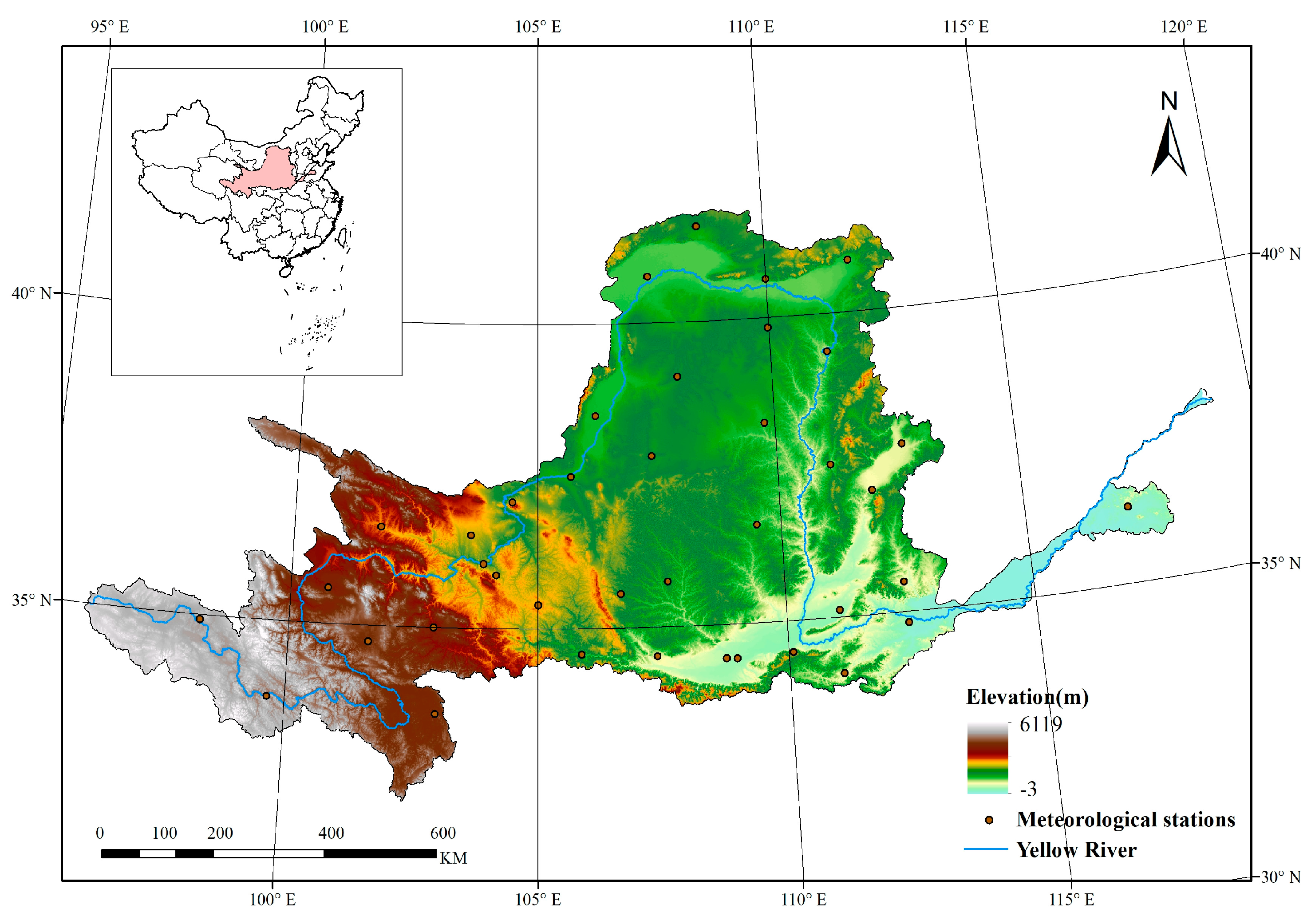
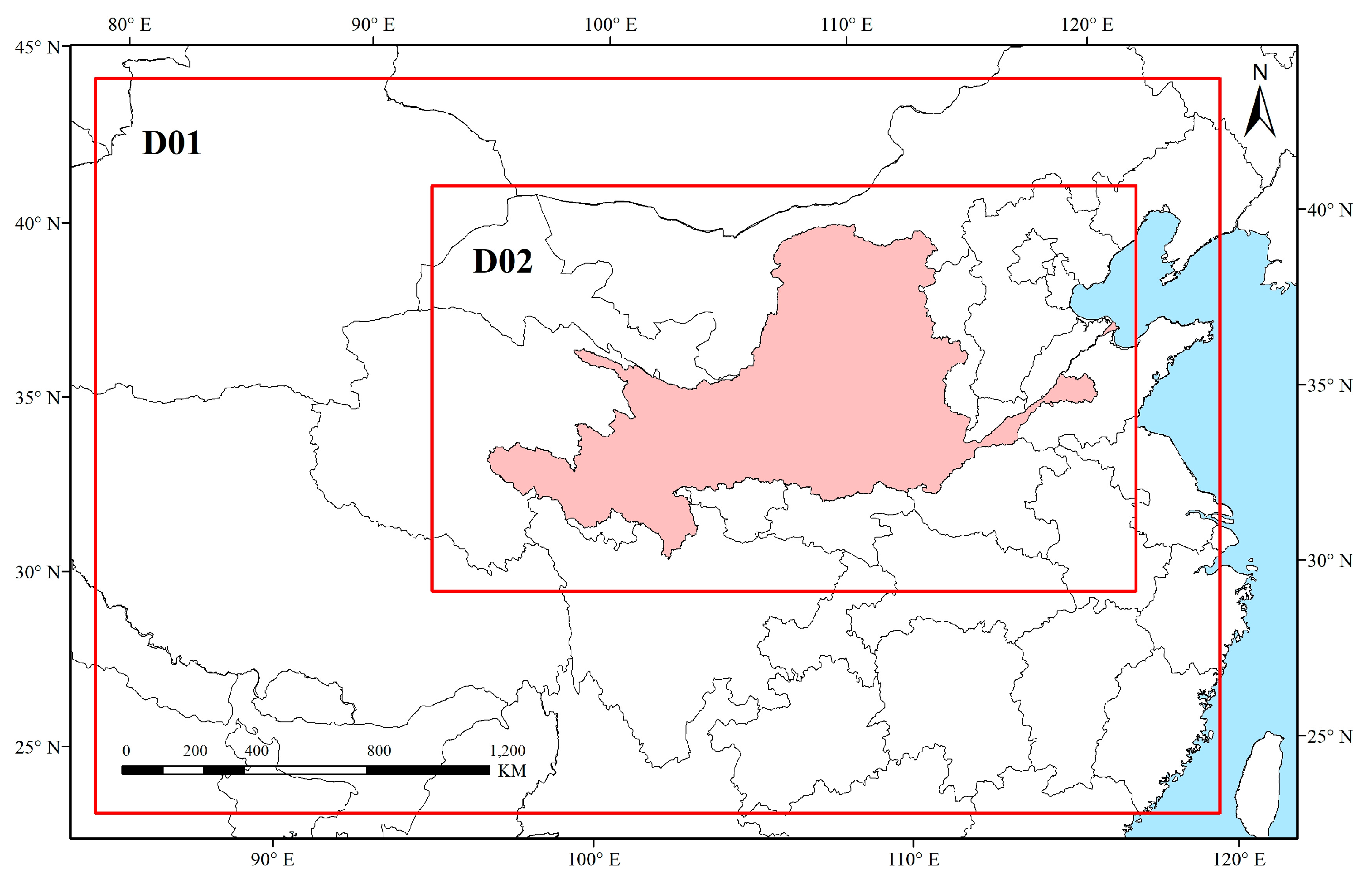
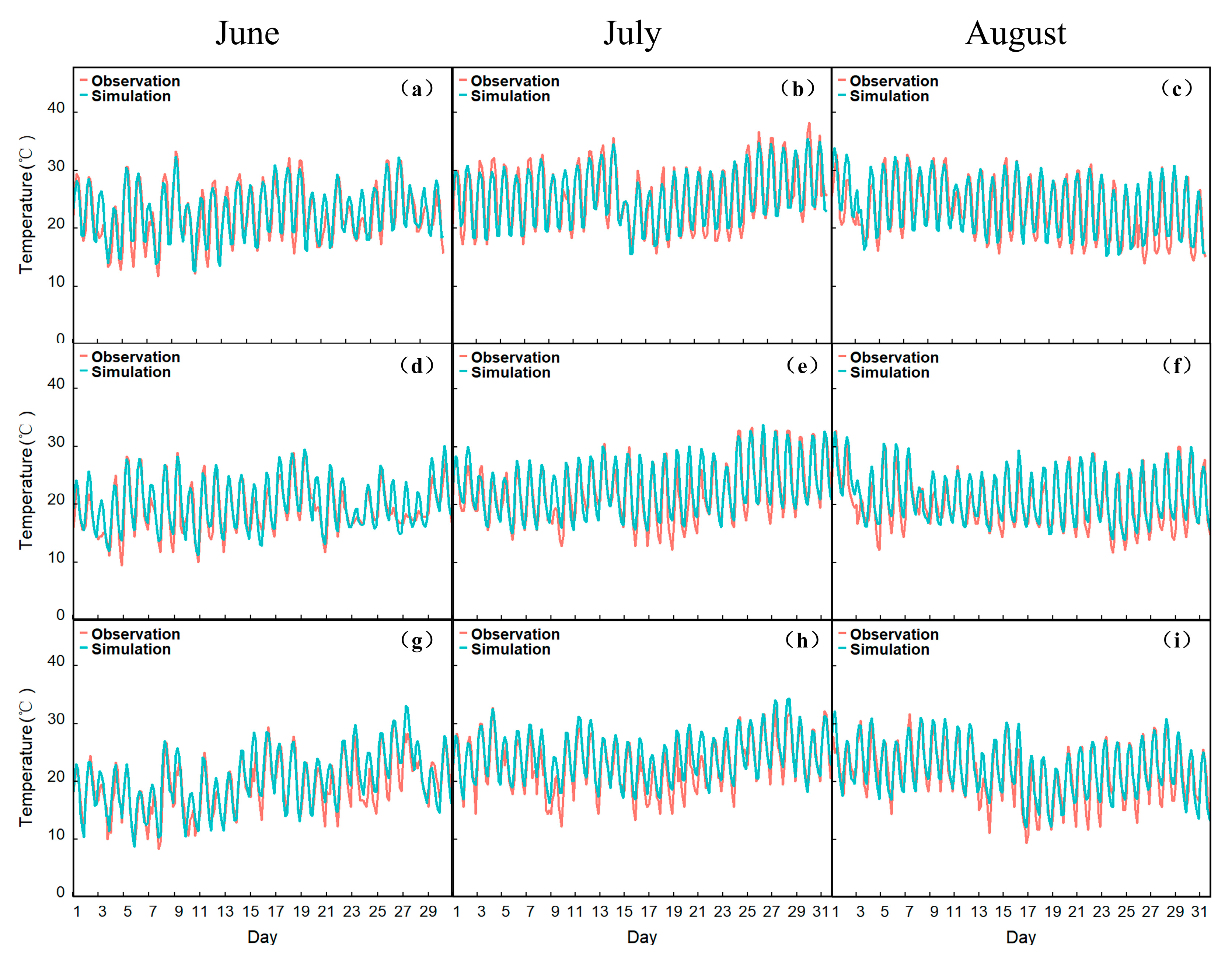
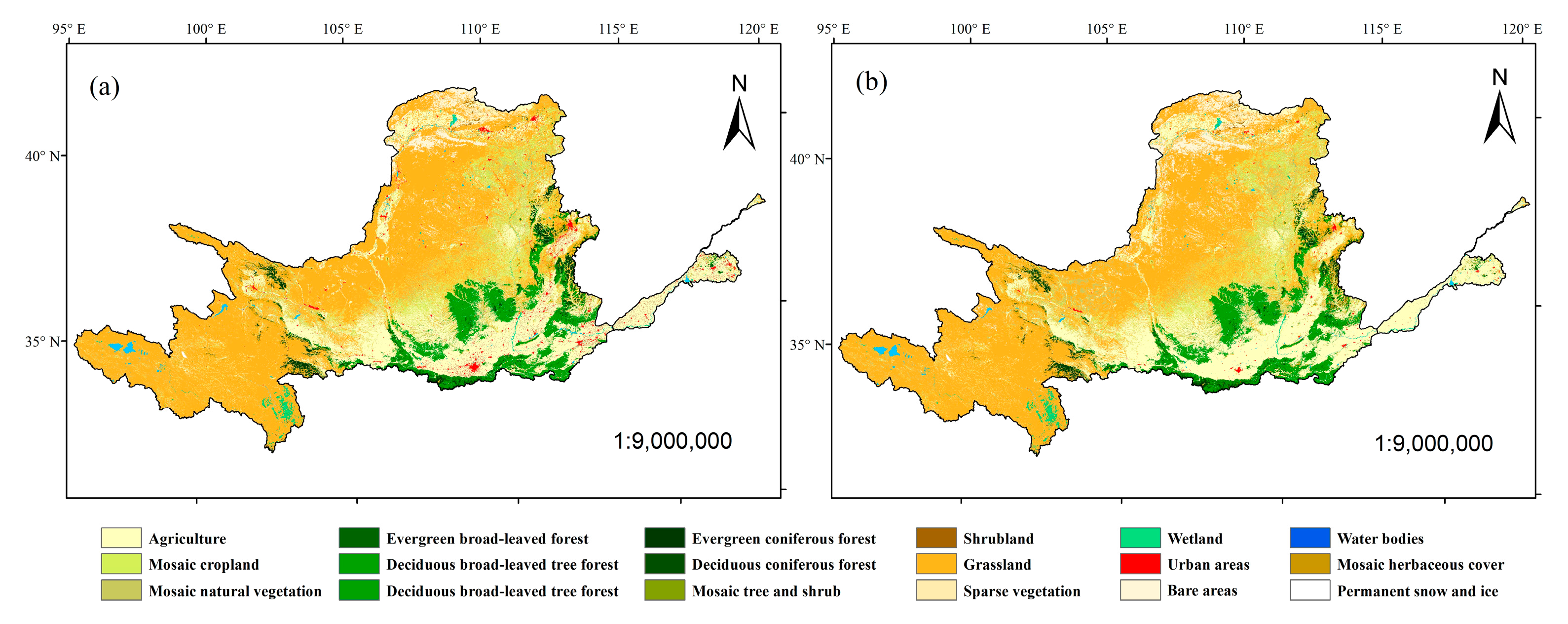
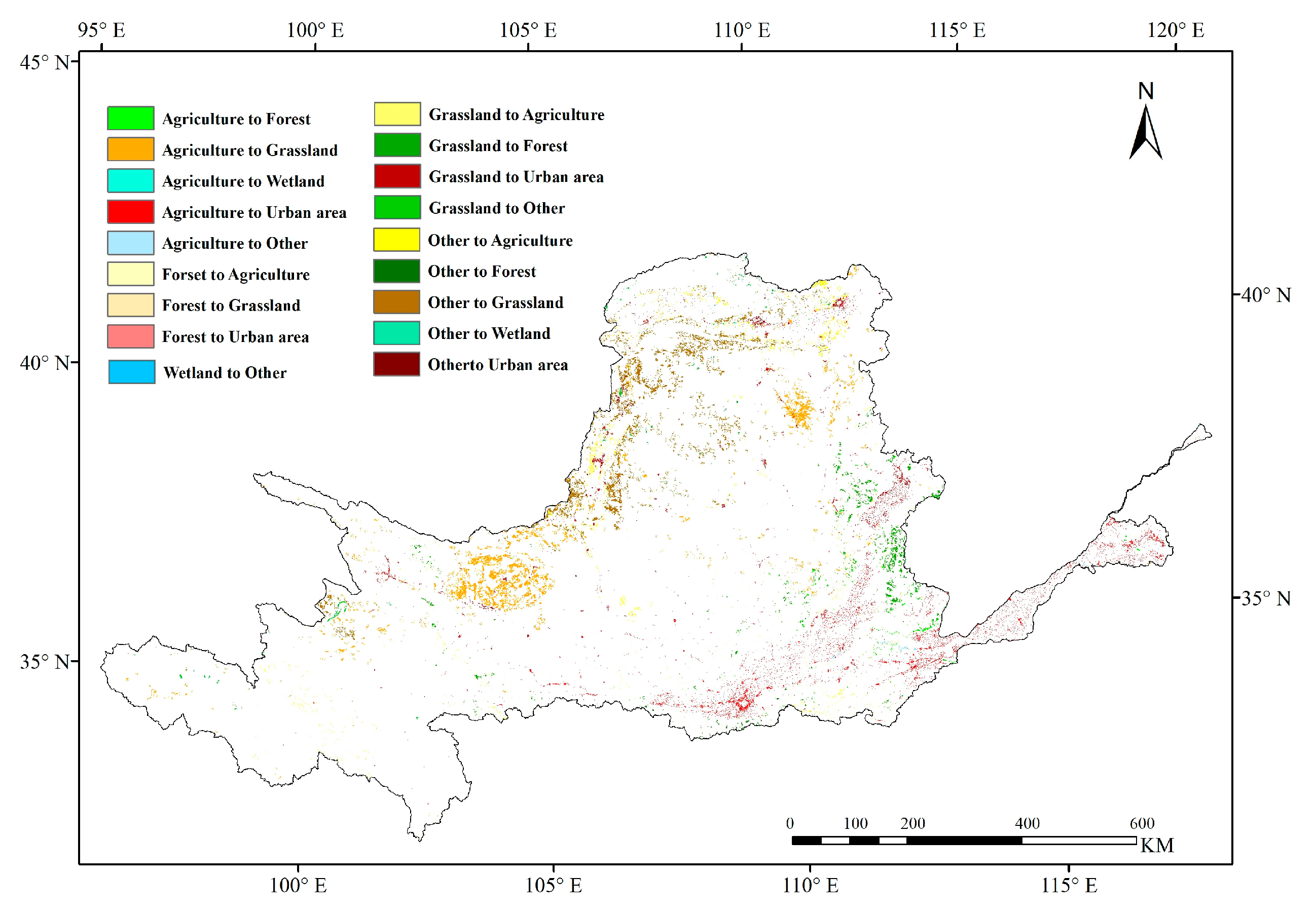
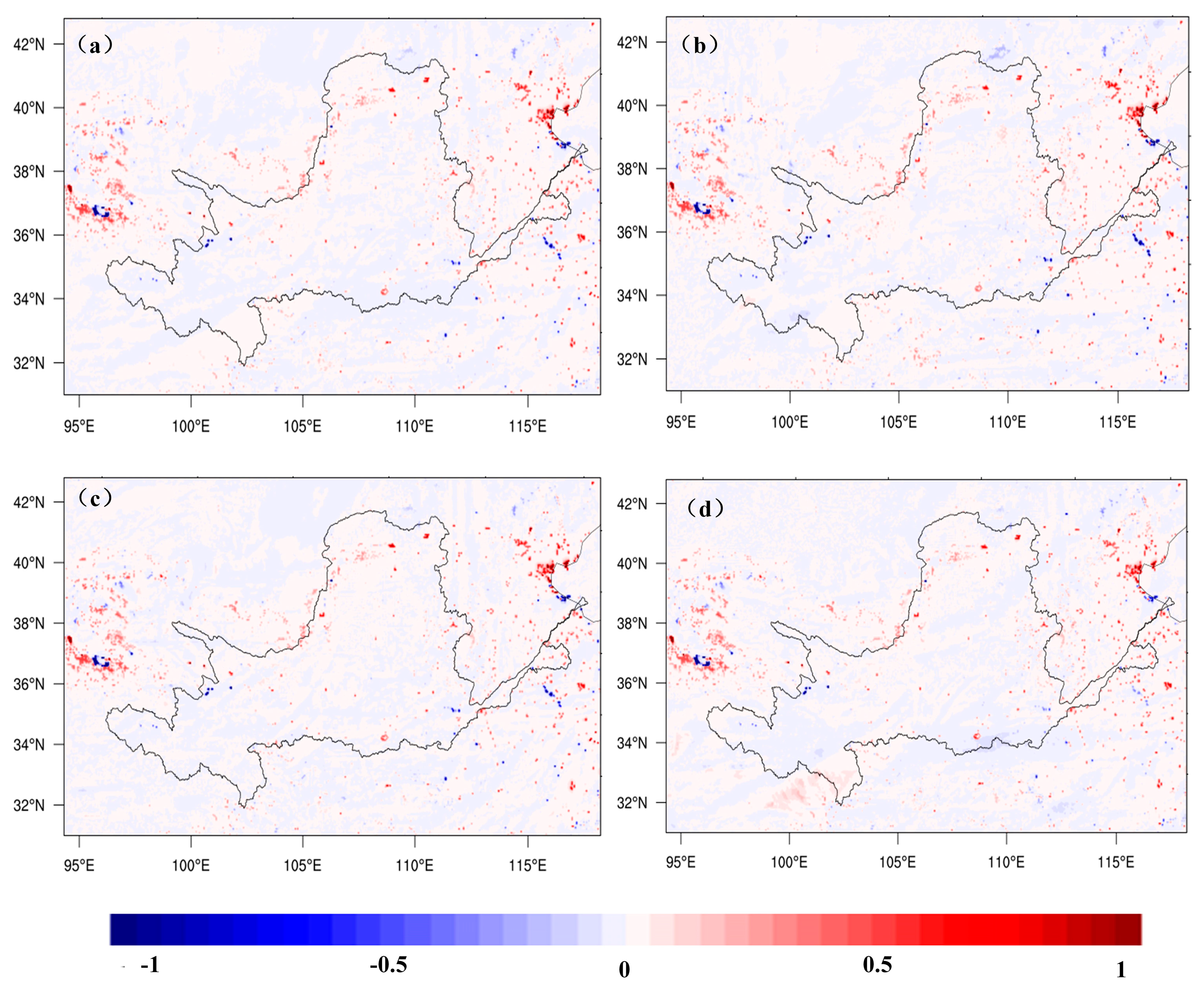
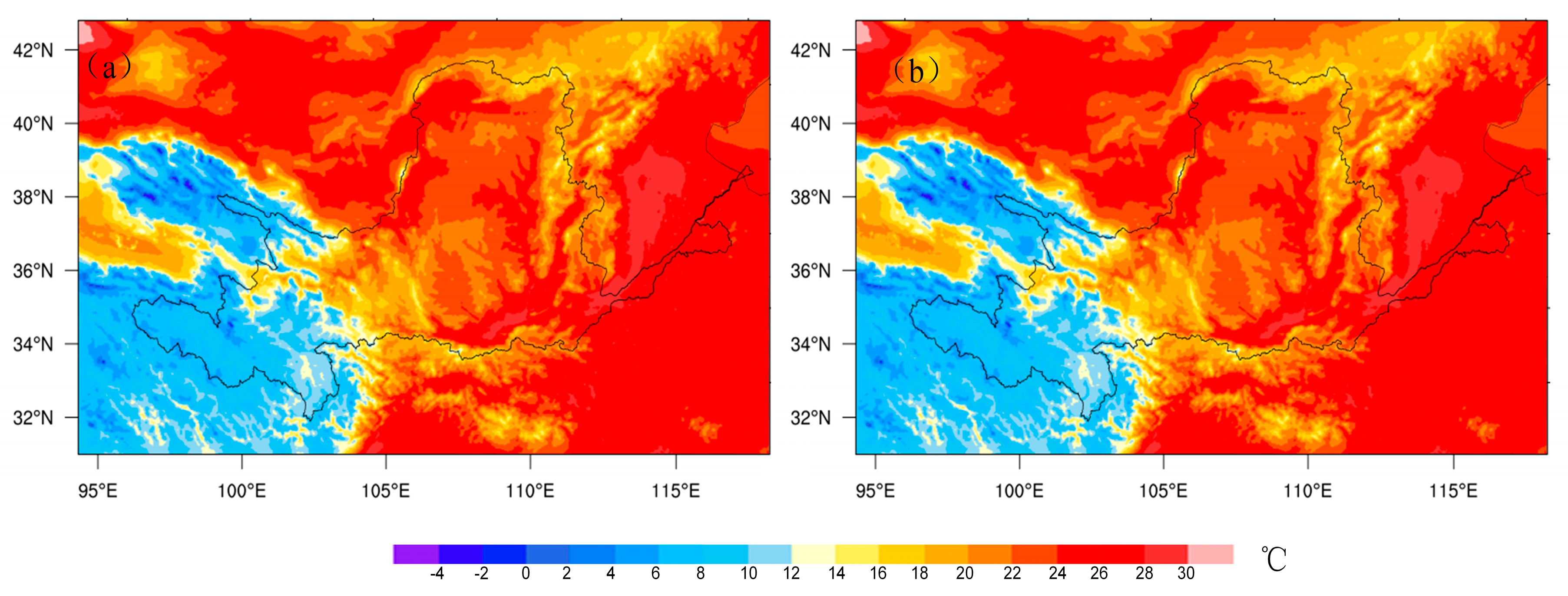
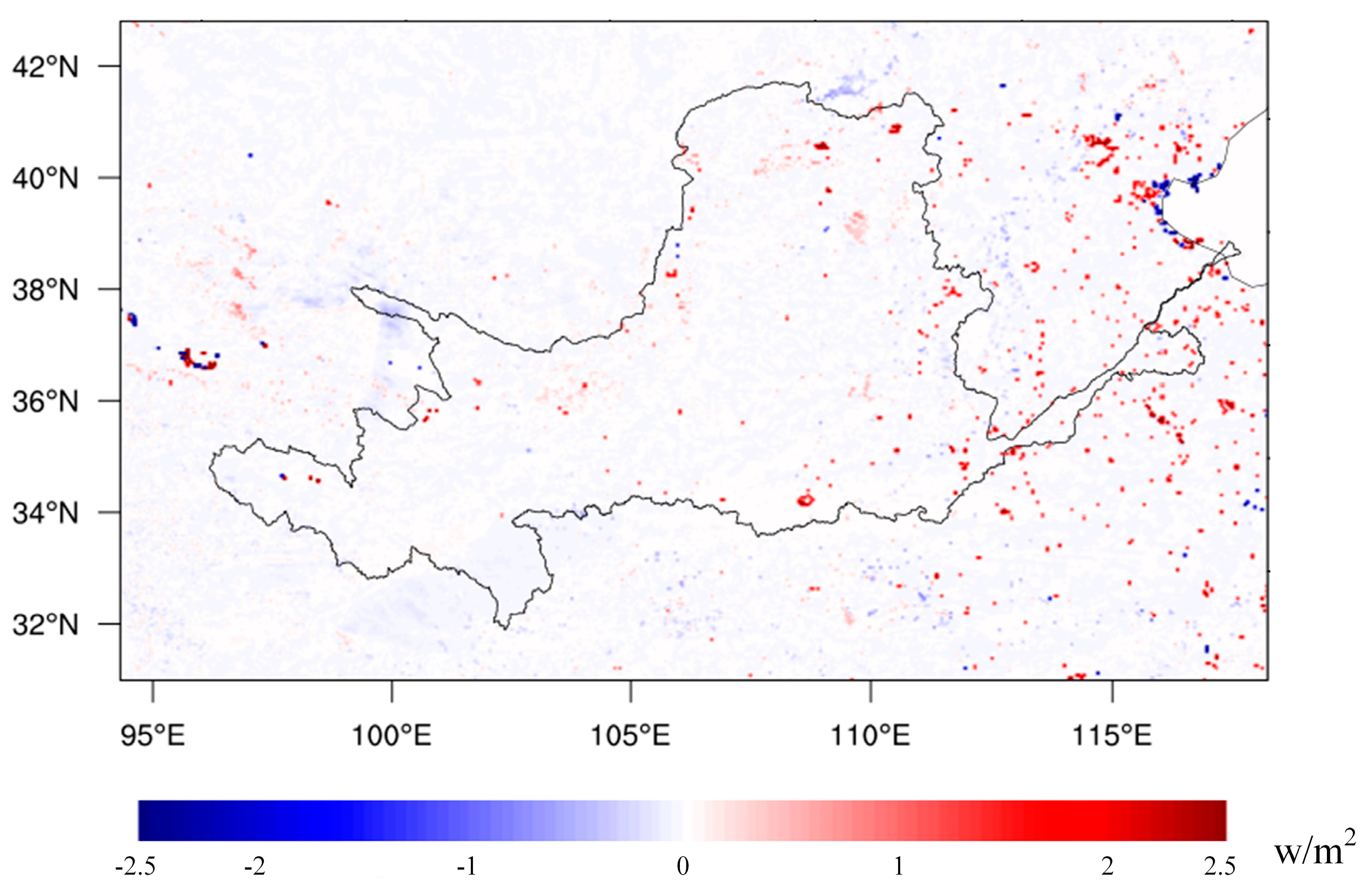

| Physical Process | Parameterization Schemes |
|---|---|
| Cumulus | BMJ |
| Land surface | Noah |
| Microphysics | Lin |
| Planetary boundary | MYJ |
| Longwave radiation | New Goddard |
| Shortwave radiation | New Goddard |
| Experiments | MB (°C) | NMB (%) | NME (%) | RMSE (°C) | R |
|---|---|---|---|---|---|
| Case2015 | 1.3 | 0.06 | 0.1 | 2.8 | 0.93 |
| Case1995 | 1.2 | 0.05 | 0.1 | 2.8 | 0.93 |
| Farmland | Forest | Grassland | Wetland | Urban Areas | Other | |
|---|---|---|---|---|---|---|
| Farmland | — | 857.97 | 11529.27 | 10.26 | 7189.29 | 286.2 |
| Forest | 420.66 | — | 111.33 | 0.99 | 27.17 | 2.07 |
| Grassland | 5271.39 | 3292.29 | — | 7.47 | 2661.48 | 688.32 |
| Wetland | — | — | 0.27 | — | 8.64 | 9.9 |
| Urban areas | — | — | — | — | — | — |
| Other | 727.74 | 221.94 | 11111.85 | 12.87 | 184.95 | — |
Publisher’s Note: MDPI stays neutral with regard to jurisdictional claims in published maps and institutional affiliations. |
© 2022 by the authors. Licensee MDPI, Basel, Switzerland. This article is an open access article distributed under the terms and conditions of the Creative Commons Attribution (CC BY) license (https://creativecommons.org/licenses/by/4.0/).
Share and Cite
Ru, X.; Song, H.; Xia, H.; Zhai, S.; Wang, Y.; Min, R.; Zhang, H.; Qiao, L. Effects of Land Use and Land Cover Change on Temperature in Summer over the Yellow River Basin, China. Remote Sens. 2022, 14, 4352. https://doi.org/10.3390/rs14174352
Ru X, Song H, Xia H, Zhai S, Wang Y, Min R, Zhang H, Qiao L. Effects of Land Use and Land Cover Change on Temperature in Summer over the Yellow River Basin, China. Remote Sensing. 2022; 14(17):4352. https://doi.org/10.3390/rs14174352
Chicago/Turabian StyleRu, Xutong, Hongquan Song, Haoming Xia, Shiyan Zhai, Yaobin Wang, Ruiqi Min, Haopeng Zhang, and Longxin Qiao. 2022. "Effects of Land Use and Land Cover Change on Temperature in Summer over the Yellow River Basin, China" Remote Sensing 14, no. 17: 4352. https://doi.org/10.3390/rs14174352
APA StyleRu, X., Song, H., Xia, H., Zhai, S., Wang, Y., Min, R., Zhang, H., & Qiao, L. (2022). Effects of Land Use and Land Cover Change on Temperature in Summer over the Yellow River Basin, China. Remote Sensing, 14(17), 4352. https://doi.org/10.3390/rs14174352







